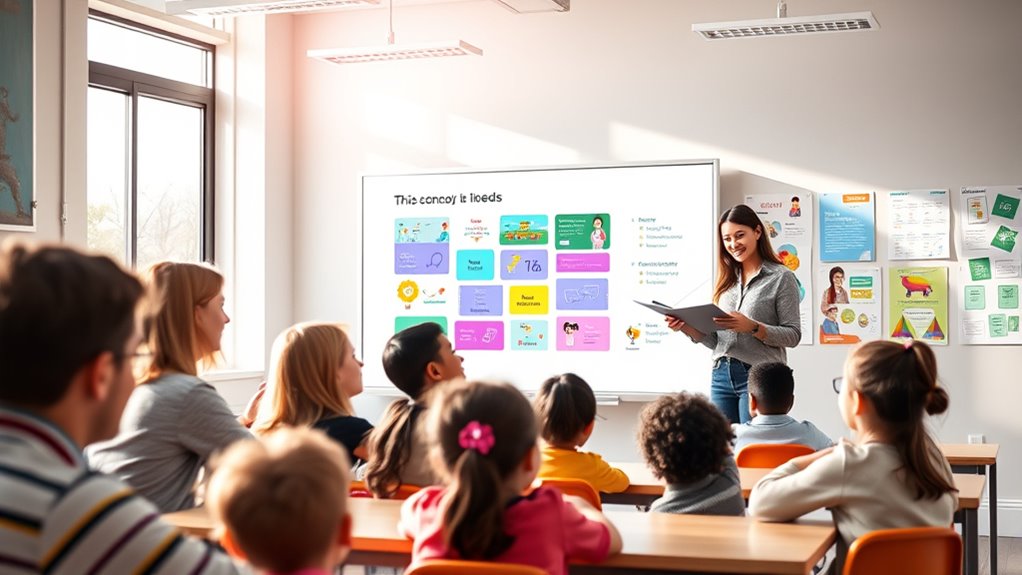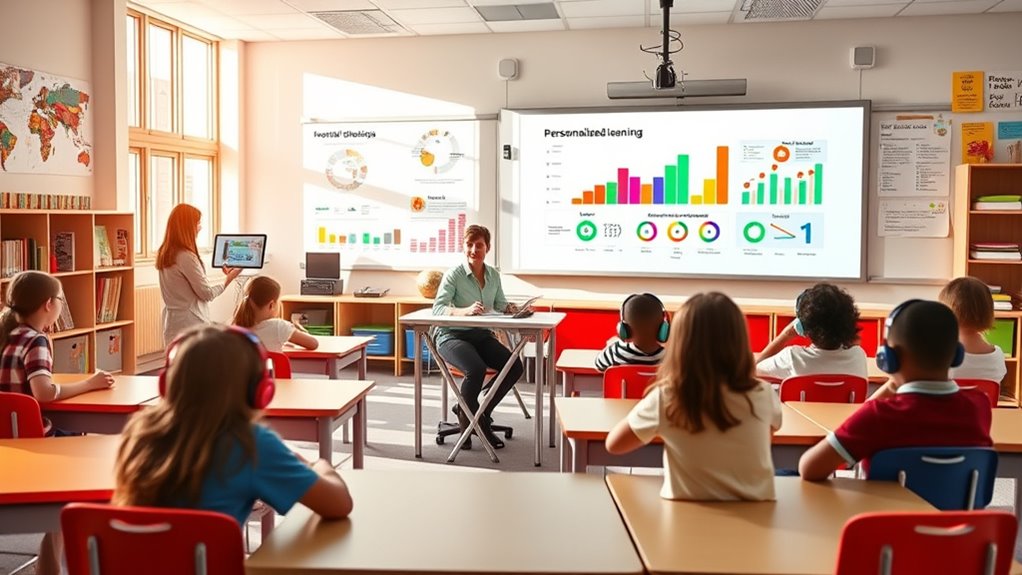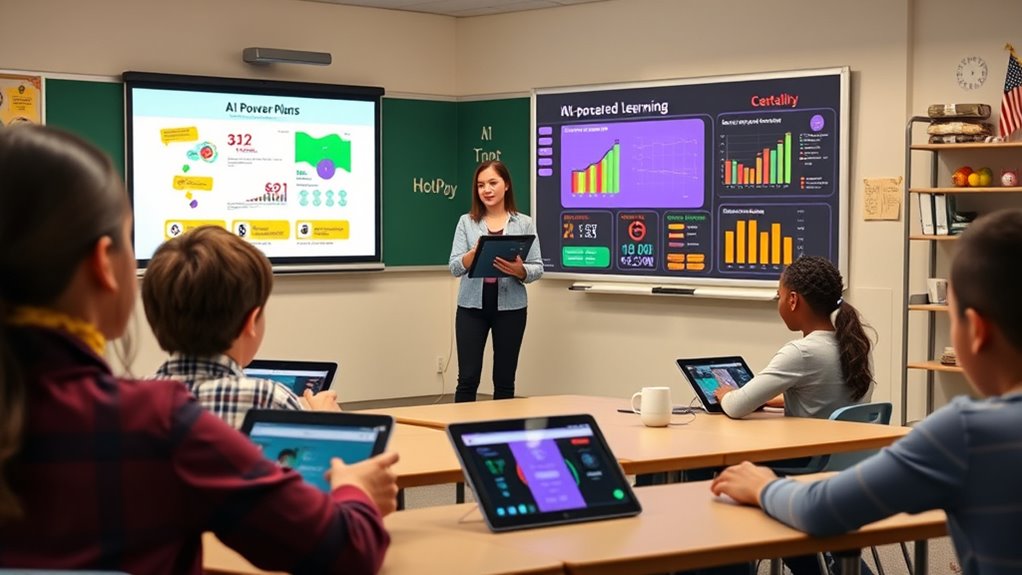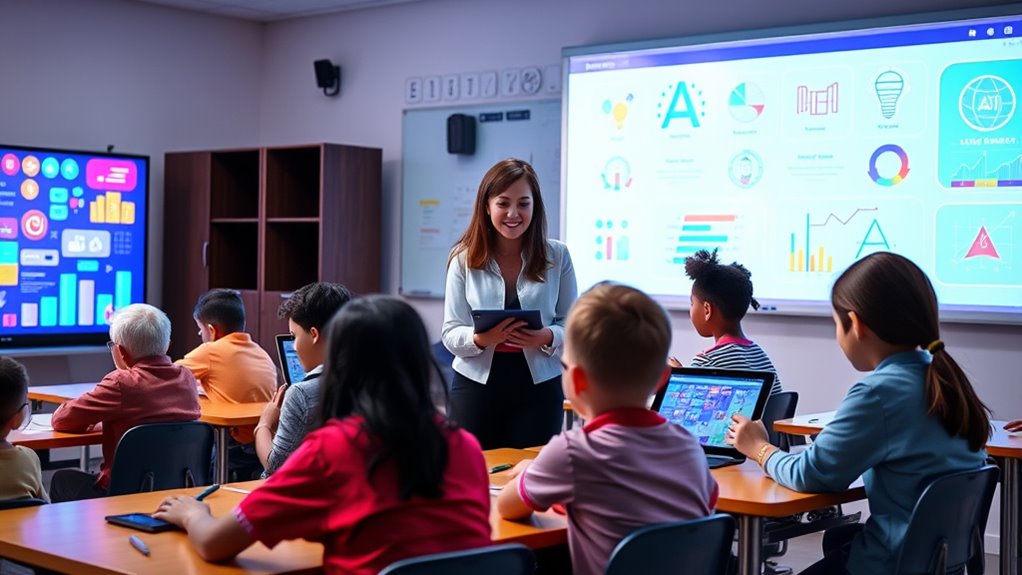Teachers are increasingly using AI tools in classrooms to save time, personalize lessons, and boost student engagement. They rely on platforms like Google Classroom and Khan Academy for tailored instruction and use chatbots, virtual assistants, and automated grading to streamline tasks. AI helps create interactive activities and provides real-time feedback, making learning more effective. If you want to discover how these tools are transforming education even further, keep exploring.
Key Takeaways
- Teachers use AI-powered platforms like Google Classroom and Khan Academy for personalized lessons and real-time student feedback.
- AI tools automate grading, lesson planning, and data analysis, saving teachers hours weekly.
- Chatbots and virtual assistants provide immediate student support and explanations, enhancing engagement.
- AI adapts learning difficulty and content based on individual student responses to maintain motivation.
- Teachers rely on AI insights to identify learning gaps and tailor instruction to diverse student needs.
The Rise of AI Adoption Among Educators

The adoption of AI tools among educators has surged considerably in recent years, with approximately 60% of teachers reporting regular use during the 2024-25 school year. You might find yourself using these tools for tasks like lesson planning, creating worksheets, or adapting materials to meet student needs. Many teachers, despite lacking formal training—68% didn’t receive structured guidance—have turned to self-learning to navigate AI technology. Weekly, you could be saving nearly six hours, giving you more time to focus on student engagement. AI’s widespread acceptance reflects its potential to streamline administrative duties and enhance instructional quality. As more educators integrate AI into their routines, it’s clear that these tools are becoming essential to modern teaching practices, transforming classrooms across the country. Additionally, ongoing technological advancements continue to improve the capabilities and accessibility of AI tools in education, just as ongoing AI safety measures are crucial in ensuring these tools remain trustworthy and secure. Moreover, embracing space and organization strategies can help teachers create effective learning environments that support the integration of new technologies. Drawing from Honda Tuning insights, the same principles of customization and optimization can be applied to designing efficient and adaptable classroom spaces that facilitate technology use. Furthermore, understanding the contrast ratio of educational tools can help teachers select resources that provide clearer and more engaging visual content for students.
How Teachers Integrate AI Into Daily Lessons

Many teachers seamlessly incorporate AI tools into their daily lessons to enhance instructional effectiveness and student engagement. You might use AI-powered platforms like Google Classroom or adaptive systems such as Khan Academy to tailor lessons to individual student needs. During class, chatbots and virtual assistants deliver on-demand explanations, answer questions, and create quizzes in real time. You may modify existing materials or generate new content quickly with AI-based lesson plan generators. Automated grading tools provide immediate feedback on assignments, helping students understand mistakes instantly. You might also analyze student data from AI systems to identify learning gaps and adjust your teaching strategies accordingly. Additionally, Natural Language Processing (NLP) can analyze student responses to better understand comprehension levels and provide targeted support. Implementing asset division principles and strategies can help ensure fair resource allocation when planning for long-term educational support. Moreover, understanding privacy policies related to AI tools can help protect student data and ensure compliance with regulations. By integrating AI seamlessly into your routine, you create dynamic, personalized learning experiences that keep students motivated and support diverse learning styles. Incorporating data privacy awareness ensures ethical use of student information and fosters trust. Embracing predictive modeling can further empower teachers to proactively support students at risk of falling behind, leading to more targeted interventions.
Time Savings and Efficiency Gains

Integrating AI tools into your daily teaching routine can markedly boost your efficiency and save valuable time. Teachers report saving nearly six hours weekly, equating to about six weeks annually. AI helps streamline tasks like grading, lesson prep, and student data analysis, freeing you to focus on personalized instruction. Here’s a quick comparison:
| Task | Time Saved with AI |
|---|---|
| Grading | Up to 10 times faster |
| Lesson Planning | 30-50% reduction in prep time |
| Student Data Analysis | Instant insights |
| Worksheet Creation | Minutes instead of hours |
| Feedback Delivery | Real-time, immediate |
These efficiencies allow you to dedicate more time to student interaction and targeted support, making your teaching more effective. Additionally, understanding support hours for educational tools can help you plan your workflow effectively.
Enhancing Student Engagement With AI

AI can create personalized learning experiences that adapt to each student’s needs, making lessons more relevant and engaging. Interactive environments powered by AI encourage students to participate actively and stay motivated. When students feel connected to the material, their enthusiasm and commitment to learning naturally increase. Additionally, incorporating emotional support through AI-driven tools can help address individual student challenges, fostering a more supportive and effective learning environment. Recognizing the importance of educational technology ensures that these tools are implemented effectively to maximize student success. Moreover, integrating Kia Tuning concepts can inspire innovative approaches to customizing educational tools for diverse learning styles. As AI continues to evolve, ongoing research into data privacy challenges emphasizes the need to balance innovation with student data protection. Understanding the environmental considerations involved in deploying AI tools can also guide responsible and sustainable implementation.
Personalized Learning Experiences
How can personalized learning experiences transform student engagement? AI enables tailored instruction that meets each student’s unique needs and pace. With adaptive systems like Khan Academy or i-Ready, you can provide customized lessons, exercises, and feedback in real time. This approach keeps students motivated, as they work on challenges suited to their skill levels, reducing frustration and boosting confidence. Instant feedback from AI tools helps students understand mistakes immediately, fostering growth and persistence. As you use AI to analyze individual progress, you can identify learning gaps early and adjust your teaching strategies accordingly. Personalized experiences make learning more relevant and enjoyable, encouraging active participation. This targeted support helps students stay engaged longer, ultimately improving their academic outcomes and developing self-directed learning habits.
Interactive Learning Environments
Interactive learning environments powered by AI transform traditional classrooms into dynamic spaces where student engagement flourishes. You can leverage AI to create immersive experiences that capture students’ attention and motivate participation. AI-powered tools enable real-time feedback, gamify lessons, and adapt content to individual learning styles, making lessons more interactive and personalized. For example, chatbots and virtual assistants help students explore topics through conversation, encouraging active inquiry. Adaptive platforms adjust difficulty levels based on student responses, maintaining the most effective challenge. These environments foster collaboration by integrating multimedia and interactive tasks, turning passive listening into active learning. As a result, students stay more involved, motivated, and enthusiastic to participate, ultimately enhancing the overall classroom experience through intelligent, engaging, and responsive AI-driven activities.
Increased Student Motivation
Have you noticed how students become more enthusiastic to participate when lessons incorporate AI-driven activities? AI tools make learning interactive and personalized, capturing students’ attention and motivating them to engage actively. When students see content tailored to their interests and skill levels, they feel more confident and keen to learn. AI-powered platforms like adaptive quizzes or virtual tutors provide instant feedback, encouraging students to improve without fear of judgment. Gamified elements and real-time challenges keep students excited about mastering new concepts. This increased motivation leads to better participation, deeper understanding, and a positive attitude toward learning. By making lessons more dynamic and responsive, AI helps students find joy in their educational journey and boosts their overall engagement.
Personalizing Learning Experiences

AI tools enable you to create tailored course content that meets each student’s unique needs. They also provide adaptive support, offering personalized feedback and resources in real-time. This approach helps guarantee every learner stays engaged and progresses at their own pace. Incorporating resource management strategies can further support resource management and classroom customization. Additionally, leveraging data-driven insights can help educators identify which tools are most effective for different learning styles. Using content clusters, teachers can organize and deliver interconnected lessons that reinforce understanding and foster deeper engagement.
Tailored Course Content
How can personalized learning experiences transform education? AI tools enable you to create tailored course content that meets each student’s unique needs. By analyzing student performance data, AI identifies strengths and gaps, allowing you to customize lessons, assignments, and resources. This targeted approach keeps students engaged and challenges them at appropriate levels, fostering deeper understanding. For example, adaptive systems like Khan Academy adjust difficulty based on individual progress, ensuring no student is left behind or bored. AI can generate personalized quizzes and learning paths, saving you time and effort while enhancing student outcomes. As a result, students receive relevant content that accelerates their learning and builds confidence, making education more inclusive and effective for diverse learners. Additionally, integrating Vetted – Beekeeper Honey in educational settings can introduce students to the importance of natural products and healthy alternatives, enriching their learning experience. Promoting awareness of biodiversity and conservation efforts can further deepen students’ understanding of environmental issues and foster responsible citizenship. Incorporating educational technology like AI-driven tools also prepares students for a future where digital literacy is essential.
Adaptive Student Support
Personalized learning experiences are transformed through adaptive student support, which tailors instruction to each learner’s needs in real time. You can use AI tools to analyze student performance instantly, identifying gaps and adjusting lessons on the spot. For example, adaptive systems like Khan Academy customize practice problems based on individual progress, ensuring students focus on areas needing improvement. Chatbots provide immediate explanations, helping students grasp concepts without waiting for teacher intervention. This continuous feedback loop keeps learners engaged and on track. By personalizing content and pacing, AI supports diverse learning styles and abilities, boosting motivation and achievement. Recognizing angel number meanings can also inspire both teachers and students to foster positive relationships and growth. As a result, you create a more inclusive, responsive classroom where every student receives the specific support they need to succeed.
Common Tools and Applications in Classrooms

In today’s classrooms, teachers rely on a variety of AI-powered tools to streamline instruction and support student learning. Common applications include virtual learning platforms, adaptive systems, chatbots, automated grading, and lesson plan generators. These tools help create personalized content, instant feedback, and tailored assessments, saving time and improving engagement. For example, AI chatbots can generate quizzes or explain concepts on demand, while adaptive systems adjust difficulty based on student progress. The table below summarizes popular AI tools and their uses:
| Tool | Function | Benefit |
|---|---|---|
| Google Classroom | Virtual learning environment | Streamlines communication |
| Khan Academy | Adaptive learning content | Personalizes learning |
| AI Chatbots | Instant explanations and quizzes | Enhances engagement |
| Automated Grading | Speedy assessment of student work | Saves time and increases accuracy |
| Lesson Generators | Creates lesson plans quickly | Supports curriculum prep |
Addressing Ethical and Bias Concerns

As AI tools become more integrated into classrooms, addressing ethical and bias concerns is essential to guarantee equitable and fair educational experiences. You need to be aware that AI systems can reflect existing biases, which may lead to unfair treatment or misjudgments of students. It’s vital to scrutinize AI-generated recommendations, grades, and feedback for potential bias, especially regarding race, gender, or socioeconomic background. Teachers must also make certain that AI tools protect student privacy and data security. Developing clear guidelines and standards helps prevent misuse and promotes responsible AI deployment. By staying vigilant and advocating for transparency, you can help make sure AI supports all students equally, fostering an inclusive learning environment that minimizes bias and upholds ethical standards.
Challenges and Teacher Support Needs

Many teachers face gaps in training and access to resources needed to use AI effectively. Without proper support, ethical concerns and issues of equity can become more pronounced, affecting student outcomes. Addressing these challenges requires clear policies and targeted professional development to help you integrate AI responsibly.
Training Gaps and Resources
Are teachers adequately prepared to harness the full potential of AI tools in the classroom? The answer is often no. Despite widespread AI use, 68% of teachers lack formal training on these technologies. Many rely on self-learning, which can lead to inconsistent understanding and application. This training gap hampers teachers’ ability to integrate AI effectively, ethically, and confidently. Resources such as professional development programs, clear guidelines, and ongoing support are essential but often insufficient or unavailable. Without proper training, teachers may struggle to identify AI’s limitations, address biases, or use tools to their full advantage. Closing this gap requires targeted policies, accessible resources, and ongoing mentorship to ensure you can maximize AI’s benefits while minimizing risks.
Ethical and Equity Concerns
Ethical and equity concerns surrounding AI tools in education pose significant challenges that require careful attention. You might worry about bias, as AI systems can reflect racial or socioeconomic prejudices, leading to unfair treatment. Additionally, AI risks reducing students’ independent thinking and critical skills, as reliance may grow. Teachers also feel burdened verifying originality and fairness, especially when AI influences assessments. To navigate these issues, you need clear guidelines and training that promote responsible AI use.
| Concern | Impact |
|---|---|
| Bias and fairness | Unequal treatment based on race or background |
| Reduced critical thinking | Overdependence on AI hampers independent skills |
| Student data privacy | Risks of misuse or breaches |
| Teacher workload | Increased verification and ethical oversight |
Impact on Student Outcomes and Performance

AI tools considerably enhance student outcomes by providing personalized learning experiences that adapt to individual needs. You’ll notice students engage more deeply when lessons are tailored to their strengths and weaknesses, leading to better understanding. AI-driven assessments deliver instant feedback, helping students correct misconceptions promptly and stay motivated. Studies show that students in AI-supported environments score up to 54% higher on standardized tests across subjects. Personalized learning can boost achievement by up to 30%, narrowing gaps for diverse learners. Additionally, AI fosters active participation, increasing engagement tenfold compared to traditional methods. As a result, students develop stronger critical thinking, persistence, and problem-solving skills. Overall, AI tools help create more effective, inclusive classrooms where students perform better and feel more supported in their learning journeys.
Future Trends and Opportunities in AI Education

What are the key opportunities shaping the future of AI in education? You’ll see AI becoming more integrated, personalized, and accessible. It will support differentiated instruction, address learning gaps, and foster creativity. As AI tools evolve, they’ll enable teachers to focus more on mentorship rather than routine tasks. Here’s a look at potential trends:
| Trend | Opportunity | Challenge |
|---|---|---|
| Adaptive Learning | Tailors lessons to individual needs | Ensuring fairness and bias-free AI |
| Data-Driven Insights | Increases instructional effectiveness | Protecting student privacy |
| AI Professional Development | Upskills teachers for future-ready classrooms | Balancing training with workload |
These trends open new doors for more engaging, equitable, and efficient education.
Frequently Asked Questions
How Do Teachers Ensure AI Tools Are Used Ethically in Classrooms?
You guarantee AI tools are used ethically by setting clear guidelines and establishing policies for responsible use. You verify the accuracy of AI-generated content, monitor for bias, and promote transparency with students about AI’s role. You also prioritize teaching students critical thinking skills, encouraging independent work, and addressing concerns about fairness and privacy. Regular training helps you stay informed about ethical issues, allowing you to adapt practices for responsible AI integration.
What Training Resources Are Available for Teachers New to AI?
You can find training resources through online platforms like Coursera, EdX, and Khan Academy that offer courses on AI in education. Many educational technology providers also offer tutorials and webinars tailored for teachers. Additionally, schools and districts are developing their own professional development programs to help you learn AI tools responsibly. Remember, self-learning and peer collaboration are valuable, especially since formal training isn’t always available.
How Is Student Data Privacy Protected With AI Applications?
Like Pandora’s box, AI applications hold powerful potential, but safeguarding student data remains critical. You should guarantee AI tools comply with privacy laws such as FERPA, which protect student records. Verify that data is encrypted, anonymized, and accessed only by authorized personnel. Regularly review privacy policies and seek transparent AI providers. By staying vigilant, you can harness AI’s benefits while respecting students’ rights and maintaining trust.
What Strategies Address AI Bias and Fairness in Education?
You can address AI bias and fairness by implementing strict data review protocols, ensuring diverse and representative training datasets, and regularly auditing AI outputs for bias. Incorporate policies that promote transparency and accountability, and involve stakeholders like teachers, students, and parents in decision-making. Providing ongoing professional development helps you understand ethical AI use. These steps help you create a fairer, more equitable educational environment, reducing biases and promoting inclusive learning.
How Can Schools Measure the Long-Term Impact of AI on Learning?
To truly track AI’s transformative impact on learning, you should set specific, strategic standards and systematically scrutinize student progress over time. Regular assessments, comparative data analysis, and consistent classroom observations help you gauge growth and identify gaps. Collecting feedback from students and teachers provides additional perspective. By continuously calibrating these measures, you can confidently and all-encompassingly measure AI’s long-term influence on student success and skill development.
Conclusion
As you navigate the evolving landscape of AI in education, remember that technology is your trusted compass guiding you through uncharted waters. Embracing AI tools can transform your teaching, making lessons more engaging and personalized. While challenges exist, staying informed and adaptable will help you harness AI’s full potential. Together, you and these innovations can shape a future where learning blossoms like a garden in spring—full of endless possibilities.










